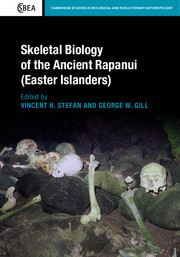Book contents
- Frontmatter
- Contents
- List of contributors
- Acknowledgements
- 1 Introduction: Research overview
- 2 Review of Polynesian and Pacific skeletal biology
- 3 Chronology and Easter Island prehistory
- 4 A descriptive skeletal biology analysis of the ancient Easter Island population
- 5 Craniometric variation of the prehistoric Polynesians and Rapanui
- 6 Rapanui non-metric cranial traits
- 7 Intra-island discrete cranial trait variation
- 8 Continuous non-metric characteristics of the early Rapanui
- 9 Rapanui dental morphology
- 10 Pelvic variability and sexual dimorphism in prehistoric Rapanui
- 11 Genetic affinities of the Rapanui
- 12 Archaeogenetics and paleodemographic estimation of founding populations: Features of residential geography on Rapa Nui
- 13 Evidence for injuries and violent death
- 14 Demographic analysis of modified crania from Rapa Nui
- 15 East Polynesian and Paleoindian parallels and contrasts in skeletal morphology
- 16 Rapanui origins, relationships, and warfare: A summary in theoretical context
- References
- Index
9 - Rapanui dental morphology
Published online by Cambridge University Press: 05 December 2015
- Frontmatter
- Contents
- List of contributors
- Acknowledgements
- 1 Introduction: Research overview
- 2 Review of Polynesian and Pacific skeletal biology
- 3 Chronology and Easter Island prehistory
- 4 A descriptive skeletal biology analysis of the ancient Easter Island population
- 5 Craniometric variation of the prehistoric Polynesians and Rapanui
- 6 Rapanui non-metric cranial traits
- 7 Intra-island discrete cranial trait variation
- 8 Continuous non-metric characteristics of the early Rapanui
- 9 Rapanui dental morphology
- 10 Pelvic variability and sexual dimorphism in prehistoric Rapanui
- 11 Genetic affinities of the Rapanui
- 12 Archaeogenetics and paleodemographic estimation of founding populations: Features of residential geography on Rapa Nui
- 13 Evidence for injuries and violent death
- 14 Demographic analysis of modified crania from Rapa Nui
- 15 East Polynesian and Paleoindian parallels and contrasts in skeletal morphology
- 16 Rapanui origins, relationships, and warfare: A summary in theoretical context
- References
- Index
Summary
Introduction
As can be seen in the chapters contained in this volume, almost every aspect of Rapanui skeletal morphology has been examined. This chapter deals specifically with the dental morphology of prehistoric Rapanui. Some research has been conducted on the dentition of the Rapanui, though these studies have been limited in their scope. The first dental study done on the 1981 Expedition sample of Rapanui skeletons involved dental pathology only (Owsley et al., 1983, 1985), and not dental morphology. An exhaustive search of the literature has revealed relatively few publications dealing with dental morphology of the Polynesians or specifically the Rapanui, a situation that has not changed significantly since Turner and Scott conducted a literature review in 1977 (Turner and Scott, 1977).
The earliest publications dealing with the dentition and dental morphology of the Polynesians, either directly or indirectly, are those written by Hrdliĉka (1920), Chappel (1927), Wissler (1931), and Riesenfeld (1956). Hrdliĉka (1920), Chappel (1927), and Wissler (1931) discussed the frequency of shovel-shaped, central, and lateral incisors among prehistoric Hawaiian individuals in comparison to a worldwide distribution of the shovel-shaped incisor trait among other populations. In addition to his examination of incisors, Chappel examined cusp numbers for the maxillary and mandibular molars (Chappel, 1927). Riesenfeld (1956) also discusses shovel-shaped incisors among native peoples of the Pacific, but only mentions an enigmatic “Polynesian” sample, without any description of its composition. Suzuki and Sakai (1964) continued the investigation of the frequency of shovel-shaped incisors among Polynesians, however, they utilized a modern, living sample of 12- to 13-year-old Polynesians of the Samoan Islands (living at the time dental casts were obtained in 1959).
More recent investigations and analyses of Polynesian dentition, or the utilization of Polynesians as reference samples, primarily involve the research of Christy G. Turner and colleagues. In 1977, Turner and Scott published the “Dentition of Easter Islanders” (1977). Data from this research, as well as those from Katich and Turner (1975), provided the “Polynesian” reference sample for an analysis of the dental crown morphology of the New Britain West Nakanai Melanesians (Turner and Swindler, 1978). In 2005, Turner utilized Polynesian samples in the analysis of a sample of Rotuma Islanders, in an attempt to identify a Polynesian or Melanesian origin (Turner, 2005).
- Type
- Chapter
- Information
- Skeletal Biology of the Ancient Rapanui (Easter Islanders) , pp. 155 - 166Publisher: Cambridge University PressPrint publication year: 2016



